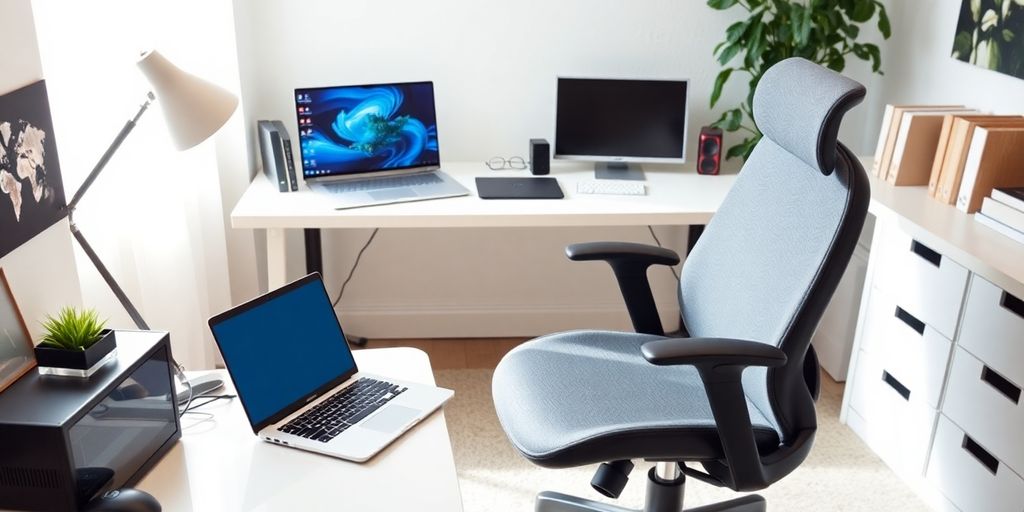5 Budget Hacks for Remote Workers: Build a Productive Workspace Without Breaking the Bank

Table of Contents
Working remotely offers unparalleled flexibility, but it’s easy to fall into the trap of overspending, or worse, under-investing in tools that harm your health and productivity. Cheap tech and furniture might seem like a win for your wallet, but they often lead to discomfort, inefficiency, and costly replacements down the line. In this deep dive, we’ll explore 5 Budget Hacks for Remote Workers that balance cost-effectiveness with long-term value, ensuring your workspace supports both your body and your budget.
Why Cheap Tech Costs You More in the Long Run
Before diving into the hacks, let’s address the elephant in the room: Why does cutting corners backfire?
- Health costs: Poor posture from non-ergonomic setups can lead to chronic pain, physiotherapy bills, or missed workdays.
- Productivity losses: Slow internet or distracting environments waste hours of focused work time.
- Replacement expenses: Cheap gear often wears out faster, forcing you to buy twice.
By prioritizing these 5 Budget Hacks for Remote Workers, you’ll avoid these hidden costs while creating a workspace that works for you.
1. Ergonomic Chair: Skip the “Budget” Options, Buy Smart
An ergonomic chair isn’t just a seat, it’s the foundation of your health. Sitting for 8+ hours daily in a poorly designed chair strains your spine, hips, and neck. But you don’t need a $1,000 model to get support.
How to Hack It:
- Buy refurbished: Companies like Crandall Office Furniture sell remanufactured Herman Miller or Steelcase chairs at 50% off retail.
- Prioritize adjustability: Look for lumbar support, seat depth adjustments, and breathable fabric.
- Test before buying: Many retailers offer 30-day return policies.
Real-World Example:
Sarah, a freelance writer, bought a $250 refurbished Steelcase Leap chair. “It eliminated my lower back pain within a week. Cheaper than my chiropractor visits!”
2. Adjustable Desk: Hack Your Posture for Pennies
Sitting all day is the new smoking. Standing desks promote circulation, focus, and energy, but new electric models can cost $500+. Here’s how to get the benefits on a budget:
How to Hack It:
- DIY a standing desk: Use sturdy shelves or stack books under your laptop.
- Buy a converter: The FlexiSpot M2B ($99) turns any desk into a standing workstation.
- Go hybrid: Alternate between a kitchen counter and your desk to avoid sitting fatigue.
Science-Backed Benefit:
A 2021 study in Applied Ergonomics found workers with sit-stand desks reported 50% less back pain and 10% higher productivity. Study Source.
3. Noise-Canceling Headphones: Silence Distractions Strategically
Background noise: kids, traffic, chatty roommates, can derail your focus. Premium noise, canceling headphones (like Sony’s WH-1000XM5) cost $400, but you can achieve similar results for less.
How to Hack It:
- Refurbished gems: Bose QuietComfort 45 refurbished pairs sell for $199 on Amazon Renewed.
- Mid-tier brands: Anker Soundcore Life Q30 ($80) offers 95% noise cancellation efficacy.
- Rent before buying: Services like Lumoid let you test headphones for a monthly fee.
Pro Tip: Pair headphones with free ambient noise apps like Noisli to mask distractions with customizable soundscapes (rain, café chatter, etc.).
4. High-Speed Internet: Optimize Your Connection for Less
Buffering during Zoom calls or sluggish uploads wastes time and frays nerves. While fiber-optic plans can cost $100/month, these hacks ensure reliability without the premium price:
How to Hack It:
- Negotiate with providers: Mention competitor rates, many will match discounts to keep you.
- Use a Wi-Fi analyzer: Apps like NetSpot identify dead zones. Place your router centrally or add a $40 TP-Link extender.
- Share costs: Split a plan with a neighbor (using a guest network for security).
Case Study:
Remote developer Mark upgraded to a mesh Wi-Fi system ($150 one-time cost) instead of paying for a pricier internet tier. “My speed doubled, and I saved $30/month.”
Pro Tip: Pair Your Setup with Time-Blocking Hacks
Even the best workspace won’t boost productivity without smart time management. For remote workers juggling multiple tasks, time-blocking is a game-changer. By scheduling focused work periods (and sticking to them!), you’ll maximize the ROI of your ergonomic setup and high-speed internet. Dive deeper into this strategy with our guide for 25 Time Blocking Hacks to Boost Your Productivity, which pairs perfectly with these 5 Budget Hacks for Remote Workers.
5. Multi-Device Charging Station: Declutter for Focus
A jungle of cords isn’t just messy, it’s a mental drain. Studies show cluttered spaces reduce concentration by 20%. A charging station organizes your tech and reduces decision fatigue.
How to Hack It:
- Use a universal dock: The Satechi 4-in-1 Wireless Charger ($99) powers iPhones, AirPods, Apple Watch, and Android devices.
- Repurpose old gear: Mount a power strip under your desk with adhesive hooks for hidden cord management.
- Go wireless: A $15 Qi pad from Amazon eliminates phone and earbud cables.
Psychological Bonus: A tidy workspace mimics the “clean desk policy” of offices, signaling your brain it’s time to work.
Bonus Hack: The 80/20 Rule for Remote Work Savings
Not all upgrades are equal. Apply the Pareto Principle:
- 20% of investments (ergonomic chair, internet) deliver 80% of your comfort and productivity gains.
- Skip the rest: Fancy RGB lighting or ultra-4K monitors can wait.
Long-Term Savings vs. Short-Term Costs
Let’s break down the math:
| Item | Cheap Option | Smart Hack | 5-Year Savings |
|---|---|---|---|
| Ergonomic Chair | $100 (wears out in 1 year) | $250 (lasts 5+ years) | $250 |
| Internet Plan | $70/month (basic) | $50/month (negotiated) | $1,200 |
| Noise-Canceling Headphones | $50 (replaced yearly) | $200 (lasts 4 years) | $150 |
Total Potential Savings: Over $1,600 in 5 years, plus avoided medical bills.
Final Thoughts: Spend Smart, Work Better
Remote work isn’t a sprint, it’s a marathon. By implementing these 5 Budget Hacks for Remote Workers, you’re not just saving money; you’re investing in your health, focus, and career longevity. Remember:
- Quality over quantity: Buy once, cry once.
- Test before committing: Use return policies or rentals.
- Repair, don’t replace: Fix gear with YouTube tutorials.
Whether you’re a digital nomad or a hybrid employee, these 5 Budget Hacks for Remote Workers ensure your workspace empowers you, not drains you.
FAQs
Q: How do I convince my employer to cover these costs?
A: Frame it as a productivity investment. Many companies offer stipends for home office setups.
Q: Are standing desks worth it if I only stand 1-2 hours a day?
A: Yes! Even short standing sessions improve circulation and reduce sedentary risks.
Q: What’s the #1 hack to start with?
A: The ergonomic chair. You can’t work efficiently if you’re in pain.
By mastering these 5 Budget Hacks for Remote Workers, you’ll build a workspace that’s both affordable and aligned with your well-being. Now go save money, and your spine.



